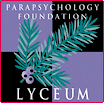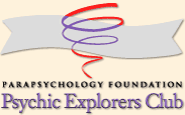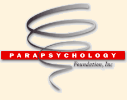 |
 |
| Eberhard W. Bauer Institut für Grenzgebiete der Psychologie & Psychohygiene In Germany the involvement with paranormal (“occult”) phenomena mirrors a long and complex tradition which is of considerable interest from both a sociohistorical as well as a cultural-historical point of view. If we take into account the development of German parapsychology from the beginning of the 19th century, four major phases or periods can be distinguished: (1) mesmerism/magnetism between 1820 and 1850; (2) “experimental spiritualism” between 1870 and 1890; (3) “scientific occultism” between 1919 and the mid-1930s; and (4) post-war parapsychology connected with the life and work of Hans Bender (1907-1991). The so-called higher phenomena of animal magnetism (e.g., traveling clairvoyance, divination, community of sensations), which could be observed as manifestations of artificially-induced magnetic sleep, constituted the basis in Germany for the first quasi-empirical investigations into what later was called the paranormal. The theoretical frame of reference had been developed by the German physician Franz Anton Mesmer (1734-1815) and his followers. For Mesmer, telepathy was something like a propagation of thoughts affecting the inner sense of man. A group of physicians, theologians, and philosophers (“pneumatologists”), heavily influenced by Schelling’s naturphilosophie and the romantic movement, tried to rediscover the “night-side of nature” including the human soul: in their opinion, the “day-light” of Enlightenment couldn’t deal adequately with this realm of life and nature. An important source for relevant observations and views of this kind is the Archiv für den Thierischen Magnetismus (1817-1827). The most important figure of the early German “occultistic” research is the physician and poet Justinus Kerner (1786-1862), who, in 1829, published his famous book Die Seherin von Prevorst (which can be read as a clinical study as well as a biography of a medium), and who was also interested in the empirical investigation of RSPK cases (Eine Erscheinung aus dem Nachtgebiete der Natur, 1836). Kerner’s book Die somnambülen Tische (1853) marks the transition period between mesmerism and the rise of spiritualism. Arthur Schopenhauer’s essay Versuch über das Geistersehn (1851) represents an important German contribution to the literature about the philosophical importance of paranormal phenomena in the first half of the 19th century. The spiritualistic movement had become quite popular in Germany in the middle of the 19th century, but experimental investigations of the phenomena in question were scarce. In the early 1870s, two factors contributed to a change in the situation: (1) In 1874 the journal Psychische Studien appeared under the editorship of Alexander Aksakow (1832-1903), and for nearly 50 years it was the most important German parapsychological journal; and (2) in 1877-1878, the noted astrophysicist Friedrich Zöllner (1834-1882) held experimental seances in Leipzig with the American medium Henry Slade (1840-1904). Zöllner’s famous “knot” and “ring” experiments, the results of which he took for an empirical proof for the existence of a four-dimensional space (Wissenschaftliche Abhandlungen, III, 1879), provoked bitter polemics. Among Zöllner’s opponents was the founding father of German experimental psychology, Wilhelm Wundt (1832-1920), who was convinced that Slade’s manifestations were produced by trickery and who feared, moreover, that the assumptions of spiritualism threatened the “higher order of the world” based on a “general causality” (Der Spiritismus, 1879). His colleague Gustav Theodor Fechner (1801-1887), however, who had also taken part in the Zöllner-Slade seances, revealed a much more tolerant position vis-a-vis paranormal phenomena (Die Tagesansicht gegenüber der Nachtansicht, 1879). Another controversy of those years, called the “animism” versus “spiritism” debate, is connected with the names of Eduard von Hartmann (1843-1906) and Alexander Aksakow. Hartmann’s book Der Spiritismus (1885) was the first attempt to give a complete psychological explanation of all occult phenomena, including subjective delusions as well as “objective” physical manifestations, without resorting, however, to hypotheses of ghosts, demons, or fraud. Aksakow’s rejoinder, Animismus und Spiritismus (1890), criticized the “hallucinations hypothesis” for not being able to deal with “objective” physical manifestations. The decade between 1880 and 1890 was dominated by the philosopher Carl du Prel (1839-1899) and his “Psychologische Gesellschaft,” founded in 1886 in Munich, which dealt mainly with the possible religious or mystical significance of occult phenomena as an underpinning of an idealistic weltanschauung; empirical work, if any, concentrated on demonstrations of a “telepathic rapport” under hypnotic influence. Under the leadership of Albert Baron von Schrenck-Notzing (1862-1929), Max Dessoir (1867-1947), and Albert Moll (1862-1939), a new society, the “Gesellschaft für Experimental-Psychologie,” was founded in Berlin in 1889, the very year when Dessoir published his seminal article “Die Parapsychologie” in the journal Sphinx (which appeared between 1886-1896). A reactivation of researchers can be observed in 1914, when Schrenck-Notzing’s much-debated book Materialisationsphänomene was published. The most intensive period of German parapsychology took place between 1919 and the establishment of National Socialism in the mid-1930s. This period was characterized by the following elements:
In 1950 Bender succeeded in establishing his famous Freiburg “Institut für Grenzgebiete der Psychologie und Psychohygiene” (IGPP). With the help of the estate of the Swiss biologist/parapsychologist Fanny Moser (1872-1953), he was able to begin a new effort to organize parapsychological research on a scientific basis, which finally led to the establishment of a chair for “Grenzgebiete der Psychologie” (Border Areas of Psychology) which existed at Freiburg University from 1954 to 1998. In addition to the foundation of a new German journal of parapsychology in 1957 (Zeitschrift für Parapsychologie und Grenzgebiete der Psychologie), that meant a partial integration of psi research into the academic framework and a first step toward its official recognition. In 1967 Bender became full professor of “Psychologie und Grenzgebiete der Psychologie,” and in 1968 he organized the 11th Annual PA Convention in Freiburg. After Bender’s retirement in 1975, his pupil Johannes Mischo (1930-2001) took over the university chair until his retirement in 1998. Bender remained director of the independent IGPP until his death in 1991. In 1981 the “Wissenschaftliche Gesellschaft zur Förderung der Parapsychologie” (WGFP) [Scientific Society for the Advancement of Parapsychology] was founded, and in 1989 it established, under the direction of physicist and psychologist Walter v. Lucadou, a “Parapsychologische Beratungsstelle” (Parapsychological Counseling Center) in Freiburg i.Br. which is funded by the state of Baden-Württemberg. Since 1983 the WGFP has started to organize workshops on parapsychology which are held in Offenburg every year and which are attended regularly by 60-70 persons. In the early nineties, with the decisive help of new funding for which Hans Bender was responsible, the IGPP could expand and restructure its scope of activities considerably. In the years to follow the Institute became one of the biggest research and funding organizations in the field of parapsychology and anomalistics. It has maintained close collaborations and ties with all major parapsychological research centers in the world. In 1996 the IGPP has left the old building at ‘Eichhalde 12’ which was erected by Bender and moved to new and modern premises in the center of Freiburg. Its central goals can be described as research, counseling, and information services in the field of parapsychological and anomalous phenomena. The Institute in its actual shape aims to develop a better empirical and theoretical understanding of psychophysical relationships (e. g. “mind-matter” problem) from broad interdisciplinary perspectives. About more than twenty scientific staff members coming from the neurosciences, clinical psychology, theoretical physics, mathematics, cultural and social sciences are currently active at the IGPP. The Institute runs also a special library comprising more than 45,000 volumes which form part of the main library of the University of Freiburg. The library subscribes approximately 300 journals, magazines and newsletters from all over the world. In addition, there is an archive focusing on all those materials (pictures, slides, films, tapes, manuscripts, letters, personal files) which may be of importance for cultural and historical aspects of both the reception of German parapsychology and of the Institute itself. Bauer, E. (1991). Periods of Historical Development of Parapsychology in Germany. In D. Delanoy (ed.), Proceedings of Presented Papers, The Parapsychological Association 34th Annual Convention (pp. 18-34). Parapsychological Association, Inc. Chéroux, C. & Fischer, A. (eds.) (2005). The Perfect Medium. Photography and the Occult. New Haven, London: Yale University Press. Sawicki, D. (2002). Leben mit den Toten. Geisterglauben und die Entstehung des Spiritismus in Deutschland 1770-1900. Padernborn: Schöningh. Tischner, R. (1960). Geschichte der Parapsychologie. Tittmoning: Pustet. Treitel, C. (2004). A Science for the Soul. Occultism and the Genesis of the German Modern. Baltimore: The Johns Hopkins University Press. Contact Information for the author: Eberhard W. Bauer (Institut für Grenzgebiete der Psychologie & Psychohygiene e.V., Wilhelmstrasse 3 A, 79098 Freiburg i.Br., Germany; email to: bauer@igpp.de |
 |

|
 www. parapsychology. org |
||